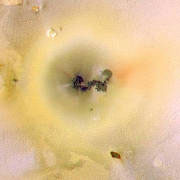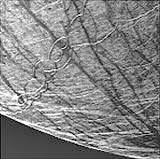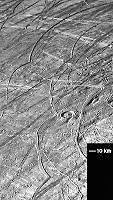|

by Wal Thornhill
from
HoloScience Website
21 October 1999
Why did the planetary
gods dominate our imagination at the dawn of civilization? Yet
nine out of ten people today could not identify bright Jupiter
in the night sky. And another question that is never asked, what was
really meant by Jupiterís weapon, the
thunderbolt?
It seems it was no earthly lightning. It moved "like a hot coal,
spat from a fire." And depictions of Jupiter show
his thunderbolt to be an odd shape rather like a
corkscrew or football. It is a form expected only from modern
plasma physics! So, if Jupiter has had a shoot-out
in the dim past, what "smoking guns" should we expect to find?
Letís look at the two large moons closest to Jupiter,
Io and Europa: As reported in
Holoscience news of 8 October,
Ioís gun is still smoking! Its surface is being spark
machined under the gaze of the Galileo spacecraft.
Geologists, handicapped by earthly comparisons, have had to resort
to volcanoes to explain what are clearly plasma jets on Io.
 What
earthly volcano has a caldera that moves tens of kilometers
in a year or two? What volcano can loft material hundreds of
kilometers into space? The dark feature is not a lava flow -
it is subsurface material exposed and burnt by the wandering arc.
There will not be a single hot caldera but rather a series of
intensely hot cathode "spots" sitting on high points
of the crater rim. They give rise to the very fast "cathode jets"
seen as faint blue radial streaks in the picture. What
earthly volcano has a caldera that moves tens of kilometers
in a year or two? What volcano can loft material hundreds of
kilometers into space? The dark feature is not a lava flow -
it is subsurface material exposed and burnt by the wandering arc.
There will not be a single hot caldera but rather a series of
intensely hot cathode "spots" sitting on high points
of the crater rim. They give rise to the very fast "cathode jets"
seen as faint blue radial streaks in the picture.
 But
it is the more distant moon, Europa, that has a frozen
record of strikes by Jupiterís thunderbolts
in the recent past. It was not a target itself but it bears the
scars from being caught in the crossfire. Just as lightning
looks for the easiest path to ground, Jupiterís
thunderbolts preferred to run across the surface of
Europa rather than through the near vacuum of space.
The result is a filamentary pattern
(click image left)
of superimposed furrows running this way and that for hundreds and
thousands of kilometers across the face of the moon. As the surface
lightning blasted its way across the moon, it heaped material to
either side to form levees. It ripped across earlier channels as if
they were not there. Jupiterís lightning was so powerful that it
converted some of the oxygen in the water ice to sulfur - creating
the dark coloration down the centre and to either side of the large
furrows. (The same process on Io over thousands of years has coated
that moon with sulfur so that it now looks like a "pizza"). But
it is the more distant moon, Europa, that has a frozen
record of strikes by Jupiterís thunderbolts
in the recent past. It was not a target itself but it bears the
scars from being caught in the crossfire. Just as lightning
looks for the easiest path to ground, Jupiterís
thunderbolts preferred to run across the surface of
Europa rather than through the near vacuum of space.
The result is a filamentary pattern
(click image left)
of superimposed furrows running this way and that for hundreds and
thousands of kilometers across the face of the moon. As the surface
lightning blasted its way across the moon, it heaped material to
either side to form levees. It ripped across earlier channels as if
they were not there. Jupiterís lightning was so powerful that it
converted some of the oxygen in the water ice to sulfur - creating
the dark coloration down the centre and to either side of the large
furrows. (The same process on Io over thousands of years has coated
that moon with sulfur so that it now looks like a "pizza").
 Geologists,
straining for an earthly explanation of Europaís appearance have
come up with cracked ice. But no ice field on Earth produces sinuous
channels with levee banks. And there is one strange pattern that has
defied sensible explanation - the hundreds of kilometers long cycloidal cracks called
flexi. Geologists,
straining for an earthly explanation of Europaís appearance have
come up with cracked ice. But no ice field on Earth produces sinuous
channels with levee banks. And there is one strange pattern that has
defied sensible explanation - the hundreds of kilometers long cycloidal cracks called
flexi.
 (A
cycloid pattern is traced out by a spot on a wheel rim as the wheel
rolls along a surface. In other words it is two kinds of motion
added together - rotational and linear -
image right). (A
cycloid pattern is traced out by a spot on a wheel rim as the wheel
rolls along a surface. In other words it is two kinds of motion
added together - rotational and linear -
image right).
  Again,
the electrical explanation is simple. We have already seen linear
motion of the arcs recorded by the straighter furrows. And circular
motion of an arc can be demonstrated in the lab by having a magnetic
field parallel to a cathode surface. So when Europa became entangled
in Jupiterís thunderbolt and the powerful magnetic fields carried
with it were momentarily draped over the moonís surface, cycloidal
furrows were simply created by rotating travelling arcs. Again,
the electrical explanation is simple. We have already seen linear
motion of the arcs recorded by the straighter furrows. And circular
motion of an arc can be demonstrated in the lab by having a magnetic
field parallel to a cathode surface. So when Europa became entangled
in Jupiterís thunderbolt and the powerful magnetic fields carried
with it were momentarily draped over the moonís surface, cycloidal
furrows were simply created by rotating travelling arcs.
Europa receives a lot of attention because it is thought to have an
ocean that might harbor life hidden under the icy surface. But if
geologistsí cracked ice models are so wide of the mark then they may
be disappointed. On the other hand, the electrical model suggests a
far more interesting history of the solar system than textbooks
allow!
|

 What
earthly volcano has a caldera that moves tens of kilometers
in a year or two? What volcano can loft material hundreds of
kilometers into space? The dark feature is not a lava flow -
it is subsurface material exposed and burnt by the wandering arc.
There will not be a single hot caldera but rather a series of
intensely hot cathode "spots" sitting on high points
of the crater rim. They give rise to the very fast "cathode jets"
seen as faint blue radial streaks in the picture.
What
earthly volcano has a caldera that moves tens of kilometers
in a year or two? What volcano can loft material hundreds of
kilometers into space? The dark feature is not a lava flow -
it is subsurface material exposed and burnt by the wandering arc.
There will not be a single hot caldera but rather a series of
intensely hot cathode "spots" sitting on high points
of the crater rim. They give rise to the very fast "cathode jets"
seen as faint blue radial streaks in the picture. 
 Geologists,
straining for an earthly explanation of Europaís appearance have
come up with cracked ice. But no ice field on Earth produces sinuous
channels with levee banks. And there is one strange pattern that has
defied sensible explanation - the hundreds of kilometers long cycloidal cracks called
flexi.
Geologists,
straining for an earthly explanation of Europaís appearance have
come up with cracked ice. But no ice field on Earth produces sinuous
channels with levee banks. And there is one strange pattern that has
defied sensible explanation - the hundreds of kilometers long cycloidal cracks called
flexi.  (A
cycloid pattern is traced out by a spot on a wheel rim as the wheel
rolls along a surface. In other words it is two kinds of motion
added together - rotational and linear -
image right).
(A
cycloid pattern is traced out by a spot on a wheel rim as the wheel
rolls along a surface. In other words it is two kinds of motion
added together - rotational and linear -
image right). 
 Again,
the electrical explanation is simple. We have already seen linear
motion of the arcs recorded by the straighter furrows. And circular
motion of an arc can be demonstrated in the lab by having a magnetic
field parallel to a cathode surface. So when Europa became entangled
in Jupiterís thunderbolt and the powerful magnetic fields carried
with it were momentarily draped over the moonís surface, cycloidal
furrows were simply created by rotating travelling arcs.
Again,
the electrical explanation is simple. We have already seen linear
motion of the arcs recorded by the straighter furrows. And circular
motion of an arc can be demonstrated in the lab by having a magnetic
field parallel to a cathode surface. So when Europa became entangled
in Jupiterís thunderbolt and the powerful magnetic fields carried
with it were momentarily draped over the moonís surface, cycloidal
furrows were simply created by rotating travelling arcs.